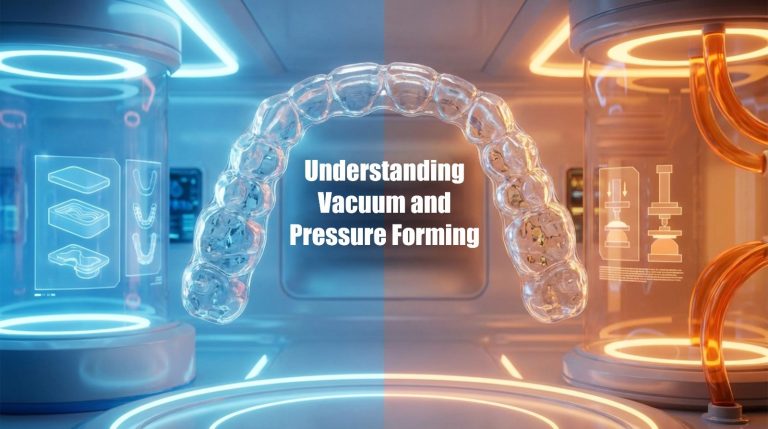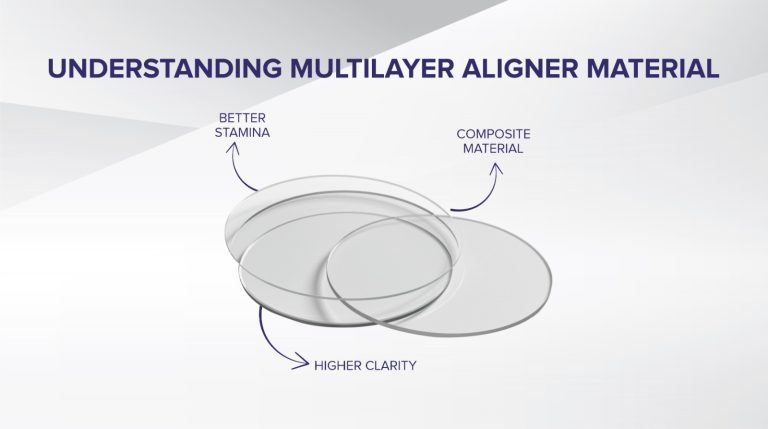Enquire Form
Unlocking the Secret to Straighter Smiles: A Comprehensive Guide to Dental Aligners Material

What are Dental Aligners?
Dental Aligners are a modern solution to treat crooked teeth. They have completely transformed the world of orthodontics. These clear & custom-made aligners come in the form of transparent trays and are intended to gently realign crooked teeth into their proper positions. Aligners act as a discreet substitute for traditional braces.
What Are the Types of Dental Aligner Materials?
The materials used to create dental aligners are crucial to the success of orthodontic treatment. These aligners are made from various materials, each with unique qualities.
Most Used Aligner Materials are as Follows:
Polyurethane Plastic:
Polyurethane plastic is a popular option known for its toughness and flexibility. Because of its malleability, it can be fitted snugly for comfort while wearing. It is perfect for individuals who want a shorter course of treatment because of its quick response to modifications.
Polyethylene:
This is a thermoplastic substance that gives the aligners a smooth, clear finish. With their smooth and transparent finish, polyethylene aligners provide a discreet choice for those who value transparency.
Polycarbonate:
Polycarbonate aligners are an excellent choice for instances that need more strength and durability. Even though the course of treatment could be lengthier, their stability is crucial for handling complicated orthodontic problems.
How Does the Type of Dental Aligner Material Affect the Process of Teeth Straightening?
The material used in dental aligners can significantly impact the straightening of teeth in your patients. Dentists who are aware of the subtleties can better make decisions for their patients and establish reasonable expectations.
Duration of Treatment:
Certain aligner materials allow faster teeth movement, resulting in a shorter treatment course. For example, polyurethane polymers are well-known for their elasticity. This property enables a quicker reaction to the recommended modifications.
On the other hand, less flexible materials require a more cautious approach. Patients who choose more durable aligners, such as polycarbonate ones, may require longer treatment times.
Dangers of Using Weak Materials:
Selecting aligners made of weak materials can endanger the treatment’s overall outcome. The low durability of these aligners can cause them to shatter or distort, making the consistent movement of the teeth more difficult. This prolongs the course of treatment and could produce less-than-ideal outcomes.
Effect on Dental Health:
Selecting the suitable aligner material is essential to preserve oral health. Germs could contaminate materials and put the surrounding dental structures at risk. Choosing premium materials reduces the chance of oral health problems and guarantees efficient teeth straightening.
How Are Dental Aligners Made?
Have you ever been curious about the detailed procedure of making orthodontic aligners? Thermoforming is a precise process that turns raw materials into aligners that fit each patient’s teeth precisely.
Digital Impressions:
The first step involves taking a digital impression of your patient’s teeth. You can use sophisticated scanning technology to create a virtual model that acts as the aligners’ blueprint by capturing detailed photos.
3D Molding or Printing:
After that, the digital model is converted into a tangible form using 3D printing or moulding. This phase is crucial since it establishes the aligners’ form and structure.
Thermoforming:
The process of thermoforming is the most essential part of making aligners. The aligner material, typically a thin sheet, is heated to a malleable temperature. After that, it is carefully placed on top of the 3D model and vacuum-sealed to take on the exact form of the teeth.
Trimming and Finishing:
The aligner is trimmed to guarantee a comfortable fit after it is cooled and solidified. After removing any extra material, the edges are polished to a flat surface.
Which Is the Best Dental Aligner Material?
Selecting the suitable dental aligner material is often necessary to pursue the ideal smile. Although preferences could differ depending on personal needs and treatment objectives, some materials have a track record of being effective. Taglus is a global industry leader in the manufacture of innovative dental aligner materials. Choosing the best aligner material depends widely on the severity of the case and the patient’s needs. Consider the benefits of all the materials and choose the right one accordingly.
Conclusion:
In summary, the path to a straighter smile necessitates carefully considering the materials used in dental aligners. Dentists and patients are more equipped to make decisions when they know how material selections affect the course of treatment, its associated risks, and affect oral health. Each material offers a unique set of advantages, such as the flexibility of polyurethane, the transparency of polyethene, or the strength of polycarbonate, all of which promise a route to a self-assured and adequately aligned smile. Taglus PU Flex, Taglus Premium and Taglus Standard give superior Aligner Sheet options to Dental professionals across the globe.
References
- Staderini, Edoardo, Giuseppe Chiusolo, Federica Guglielmi, Massimiliano Papi, Giordano Perini, Michele Tepedino, and Patrizia Gallenzi. 2024. “Effects of Thermoforming on the Mechanical, Optical, Chemical, and Morphological Properties of PET-G: In Vitro Study” Polymers 16, no. 2: 203. https://doi.org/10.3390/polym16020203
Know More About Us
SignUp To Our Newsletter And Get To Know More About Taglus
Copyrights@taglus-2025
*Taglus is a trademark of Vedia Solutions










Leave a Reply